Bibliotheken mit Kaminumrandung aus Beton Ideen und Design
Suche verfeinern:
Budget
Sortieren nach:Heute beliebt
41 – 60 von 470 Fotos
1 von 3
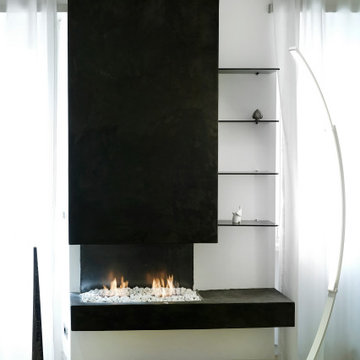
Mittelgroße, Offene Moderne Bibliothek mit weißer Wandfarbe, hellem Holzboden, Hängekamin, Kaminumrandung aus Beton, Multimediawand und beigem Boden in Rom
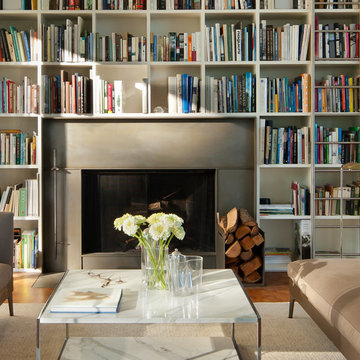
Sean Airhart
Mittelgroße, Offene Moderne Bibliothek mit weißer Wandfarbe, Kamin und Kaminumrandung aus Beton in Seattle
Mittelgroße, Offene Moderne Bibliothek mit weißer Wandfarbe, Kamin und Kaminumrandung aus Beton in Seattle
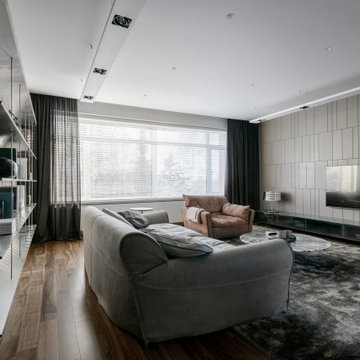
Große Moderne Bibliothek mit grauer Wandfarbe, braunem Holzboden, Gaskamin, Kaminumrandung aus Beton, TV-Wand und braunem Boden in Novosibirsk
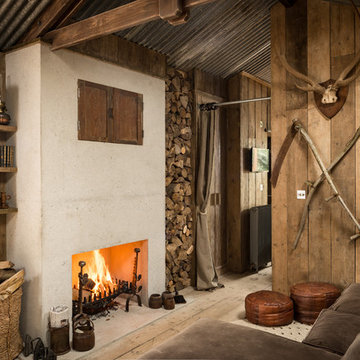
Rustikale Bibliothek mit hellem Holzboden, Kamin, verstecktem TV und Kaminumrandung aus Beton in Cornwall
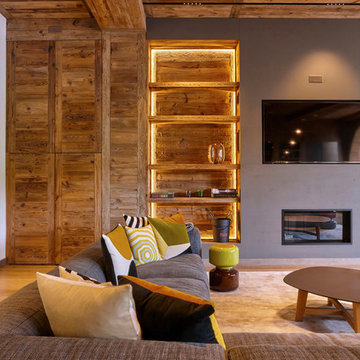
Bibliothèque vieux bois.revêtement cheminée béton
Rail lumineux encastré dans un plafond vieux bois
Sébastien Veronese
Große, Offene Moderne Bibliothek mit weißer Wandfarbe, hellem Holzboden, Kamin, Kaminumrandung aus Beton und Multimediawand in Lyon
Große, Offene Moderne Bibliothek mit weißer Wandfarbe, hellem Holzboden, Kamin, Kaminumrandung aus Beton und Multimediawand in Lyon
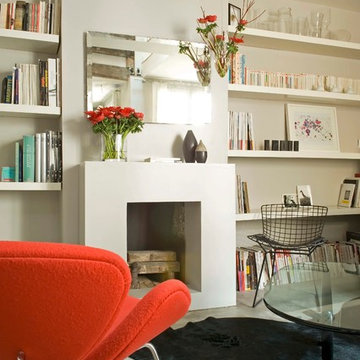
Coté paris / photographe Levasseur
Große, Offene Moderne Bibliothek mit weißer Wandfarbe, Betonboden, Kamin und Kaminumrandung aus Beton in Paris
Große, Offene Moderne Bibliothek mit weißer Wandfarbe, Betonboden, Kamin und Kaminumrandung aus Beton in Paris
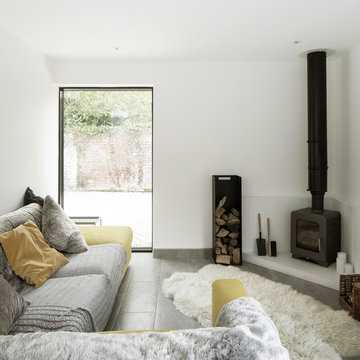
Photography by Richard Chivers https://www.rchivers.co.uk/
Marshall House is an extension to a Grade II listed dwelling in the village of Twyford, near Winchester, Hampshire. The original house dates from the 17th Century, although it had been remodelled and extended during the late 18th Century.
The clients contacted us to explore the potential to extend their home in order to suit their growing family and active lifestyle. Due to the constraints of living in a listed building, they were unsure as to what development possibilities were available. The brief was to replace an existing lean-to and 20th century conservatory with a new extension in a modern, contemporary approach. The design was developed in close consultation with the local authority as well as their historic environment department, in order to respect the existing property and work to achieve a positive planning outcome.
Like many older buildings, the dwelling had been adjusted here and there, and updated at numerous points over time. The interior of the existing property has a charm and a character - in part down to the age of the property, various bits of work over time and the wear and tear of the collective history of its past occupants. These spaces are dark, dimly lit and cosy. They have low ceilings, small windows, little cubby holes and odd corners. Walls are not parallel or perpendicular, there are steps up and down and places where you must watch not to bang your head.
The extension is accessed via a small link portion that provides a clear distinction between the old and new structures. The initial concept is centred on the idea of contrasts. The link aims to have the effect of walking through a portal into a seemingly different dwelling, that is modern, bright, light and airy with clean lines and white walls. However, complementary aspects are also incorporated, such as the strategic placement of windows and roof lights in order to cast light over walls and corners to create little nooks and private views. The overall form of the extension is informed by the awkward shape and uses of the site, resulting in the walls not being parallel in plan and splaying out at different irregular angles.
Externally, timber larch cladding is used as the primary material. This is painted black with a heavy duty barn paint, that is both long lasting and cost effective. The black finish of the extension contrasts with the white painted brickwork at the rear and side of the original house. The external colour palette of both structures is in opposition to the reality of the interior spaces. Although timber cladding is a fairly standard, commonplace material, visual depth and distinction has been created through the articulation of the boards. The inclusion of timber fins changes the way shadows are cast across the external surface during the day. Whilst at night, these are illuminated by external lighting.
A secondary entrance to the house is provided through a concealed door that is finished to match the profile of the cladding. This opens to a boot/utility room, from which a new shower room can be accessed, before proceeding to the new open plan living space and dining area.
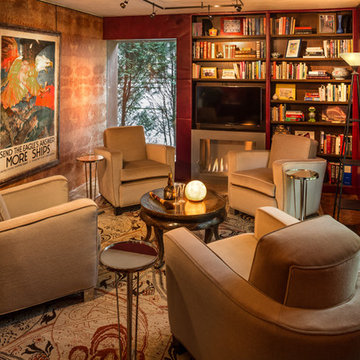
Edmunds Studios
Kleine, Abgetrennte Urige Bibliothek mit Kamin, Kaminumrandung aus Beton, TV-Wand, roter Wandfarbe und dunklem Holzboden in Milwaukee
Kleine, Abgetrennte Urige Bibliothek mit Kamin, Kaminumrandung aus Beton, TV-Wand, roter Wandfarbe und dunklem Holzboden in Milwaukee
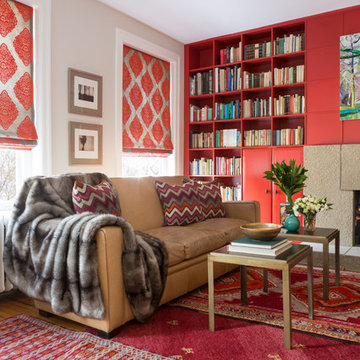
Red built-in bookcases, layered Persian rugs, and a concrete fireplace brighten this eclectic DC Library/Famiy room. Photo credit: Angie Seckinger
Große, Fernseherlose, Offene Eklektische Bibliothek mit grauer Wandfarbe, Teppichboden, Kamin und Kaminumrandung aus Beton in Washington, D.C.
Große, Fernseherlose, Offene Eklektische Bibliothek mit grauer Wandfarbe, Teppichboden, Kamin und Kaminumrandung aus Beton in Washington, D.C.
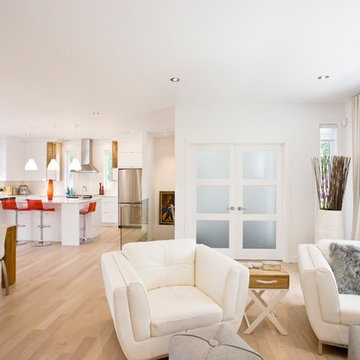
Living Room - house by Construction McKinley located in Quebec, Quebec, Canada
Große, Offene Moderne Bibliothek mit weißer Wandfarbe, hellem Holzboden, Eckkamin, Kaminumrandung aus Beton, Multimediawand und beigem Boden in Sonstige
Große, Offene Moderne Bibliothek mit weißer Wandfarbe, hellem Holzboden, Eckkamin, Kaminumrandung aus Beton, Multimediawand und beigem Boden in Sonstige
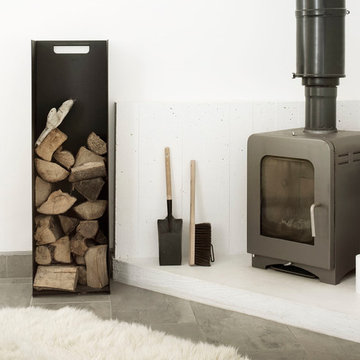
Photography by Richard Chivers https://www.rchivers.co.uk/
Marshall House is an extension to a Grade II listed dwelling in the village of Twyford, near Winchester, Hampshire. The original house dates from the 17th Century, although it had been remodelled and extended during the late 18th Century.
The clients contacted us to explore the potential to extend their home in order to suit their growing family and active lifestyle. Due to the constraints of living in a listed building, they were unsure as to what development possibilities were available. The brief was to replace an existing lean-to and 20th century conservatory with a new extension in a modern, contemporary approach. The design was developed in close consultation with the local authority as well as their historic environment department, in order to respect the existing property and work to achieve a positive planning outcome.
Like many older buildings, the dwelling had been adjusted here and there, and updated at numerous points over time. The interior of the existing property has a charm and a character - in part down to the age of the property, various bits of work over time and the wear and tear of the collective history of its past occupants. These spaces are dark, dimly lit and cosy. They have low ceilings, small windows, little cubby holes and odd corners. Walls are not parallel or perpendicular, there are steps up and down and places where you must watch not to bang your head.
The extension is accessed via a small link portion that provides a clear distinction between the old and new structures. The initial concept is centred on the idea of contrasts. The link aims to have the effect of walking through a portal into a seemingly different dwelling, that is modern, bright, light and airy with clean lines and white walls. However, complementary aspects are also incorporated, such as the strategic placement of windows and roof lights in order to cast light over walls and corners to create little nooks and private views. The overall form of the extension is informed by the awkward shape and uses of the site, resulting in the walls not being parallel in plan and splaying out at different irregular angles.
Externally, timber larch cladding is used as the primary material. This is painted black with a heavy duty barn paint, that is both long lasting and cost effective. The black finish of the extension contrasts with the white painted brickwork at the rear and side of the original house. The external colour palette of both structures is in opposition to the reality of the interior spaces. Although timber cladding is a fairly standard, commonplace material, visual depth and distinction has been created through the articulation of the boards. The inclusion of timber fins changes the way shadows are cast across the external surface during the day. Whilst at night, these are illuminated by external lighting.
A secondary entrance to the house is provided through a concealed door that is finished to match the profile of the cladding. This opens to a boot/utility room, from which a new shower room can be accessed, before proceeding to the new open plan living space and dining area.
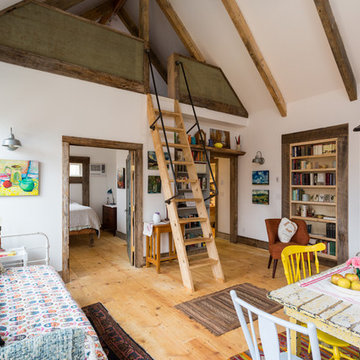
Swartz Photography
Kleine, Fernseherlose Landhaus Bibliothek im Loft-Stil mit weißer Wandfarbe, hellem Holzboden, Kaminofen und Kaminumrandung aus Beton in Sonstige
Kleine, Fernseherlose Landhaus Bibliothek im Loft-Stil mit weißer Wandfarbe, hellem Holzboden, Kaminofen und Kaminumrandung aus Beton in Sonstige
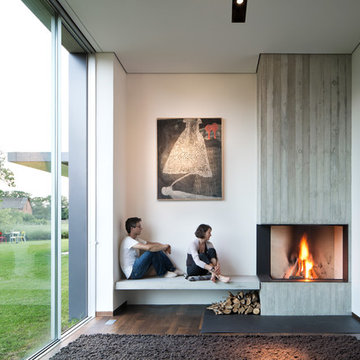
Werner Huthmacher
Mittelgroße, Abgetrennte Moderne Bibliothek mit Eckkamin, weißer Wandfarbe, dunklem Holzboden und Kaminumrandung aus Beton in Berlin
Mittelgroße, Abgetrennte Moderne Bibliothek mit Eckkamin, weißer Wandfarbe, dunklem Holzboden und Kaminumrandung aus Beton in Berlin
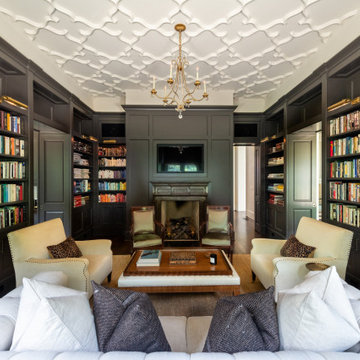
Große, Offene Klassische Bibliothek mit beiger Wandfarbe, dunklem Holzboden, Kamin, Kaminumrandung aus Beton, TV-Wand und braunem Boden in Atlanta
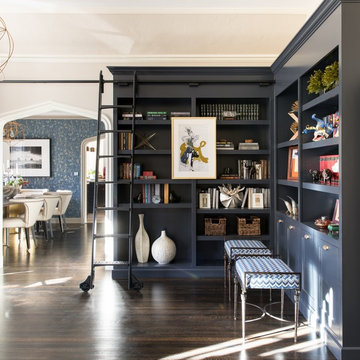
Living Room with Built-in Bookcase, Photo by David Lauer Photography
Große, Fernseherlose, Offene Klassische Bibliothek mit beiger Wandfarbe, dunklem Holzboden, Kamin, Kaminumrandung aus Beton und braunem Boden in Denver
Große, Fernseherlose, Offene Klassische Bibliothek mit beiger Wandfarbe, dunklem Holzboden, Kamin, Kaminumrandung aus Beton und braunem Boden in Denver
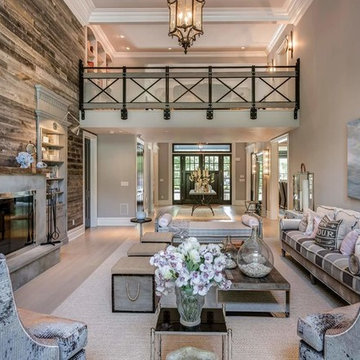
Große, Fernseherlose Landhausstil Bibliothek mit grauer Wandfarbe, hellem Holzboden, Kamin und Kaminumrandung aus Beton in New York
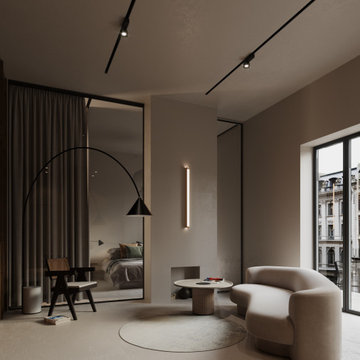
Non sempre i metri quadri contano. Ovvero ci sono spazi piccoli che sembrano grandi se pensati bene e viceversa. Cambiando planimetria e facendo un bel progetto di finiture e selezione arredo si riesce a creare spazi più ariosi ed ampi.
Qualche mese ci è capitato un progetto di una casa, questa volta a Milano, di 70mq circa. Casa con planimetria fatta da corridoio lungo e buoio, 2 camere piccoline, una cucina minuscola e un bagnetto. Lo scopo era ricavare massimo di aria ma lasciare la possibilità di creare privacy delle certe zone.
Così è nato questo progetto in stile nordico minimale. Pulito. Con un minimo di massa. Unica parete vera - quella del bagno. Camera da letto separata dal living con un divisorio in vetro che si può chiudere con una tenda coprente. Unico blocco “solido” è il volume che funge da camino.
Luce lineare. Minimo di arredo. Finitura omogenea. Unico colore che copre tutto lasciando a volte “la parola” a degli elementi in legno o alle linee nere dei profili.
Pace. Tranquillità. Completezza. Respiro. E aria.
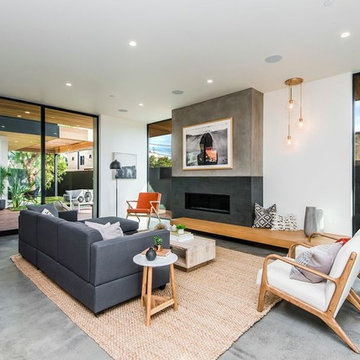
Candy
Große, Fernseherlose Moderne Bibliothek im Loft-Stil mit bunten Wänden, Betonboden, Hängekamin, Kaminumrandung aus Beton und grauem Boden in Los Angeles
Große, Fernseherlose Moderne Bibliothek im Loft-Stil mit bunten Wänden, Betonboden, Hängekamin, Kaminumrandung aus Beton und grauem Boden in Los Angeles
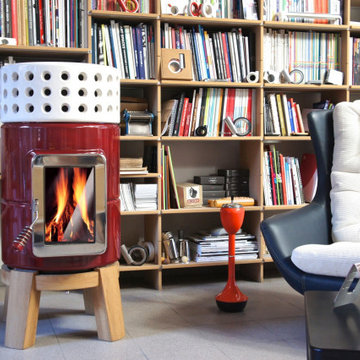
The Wittus Danish Modern inspired Stack Wood Stove with wooden base, from Maine's Chilton Furniture Co.
Kleine Nordische Bibliothek mit Linoleum, Kaminofen, Kaminumrandung aus Beton und weißem Boden in Portland Maine
Kleine Nordische Bibliothek mit Linoleum, Kaminofen, Kaminumrandung aus Beton und weißem Boden in Portland Maine
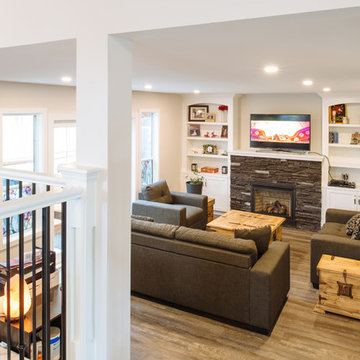
Revival Arts Photography Clients enjoys their time with friends and family or watching a movie with their kids. Storage for books and media entertainment provided. A gas fireplace allows warmth and comfort on chilly evenings.
Bibliotheken mit Kaminumrandung aus Beton Ideen und Design
3